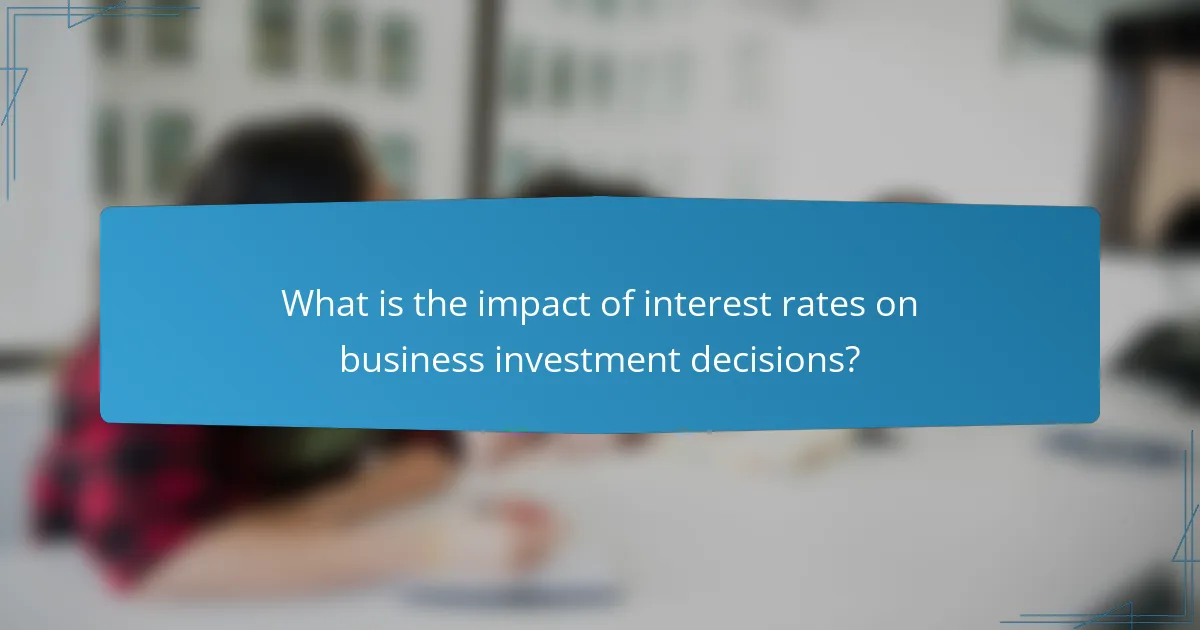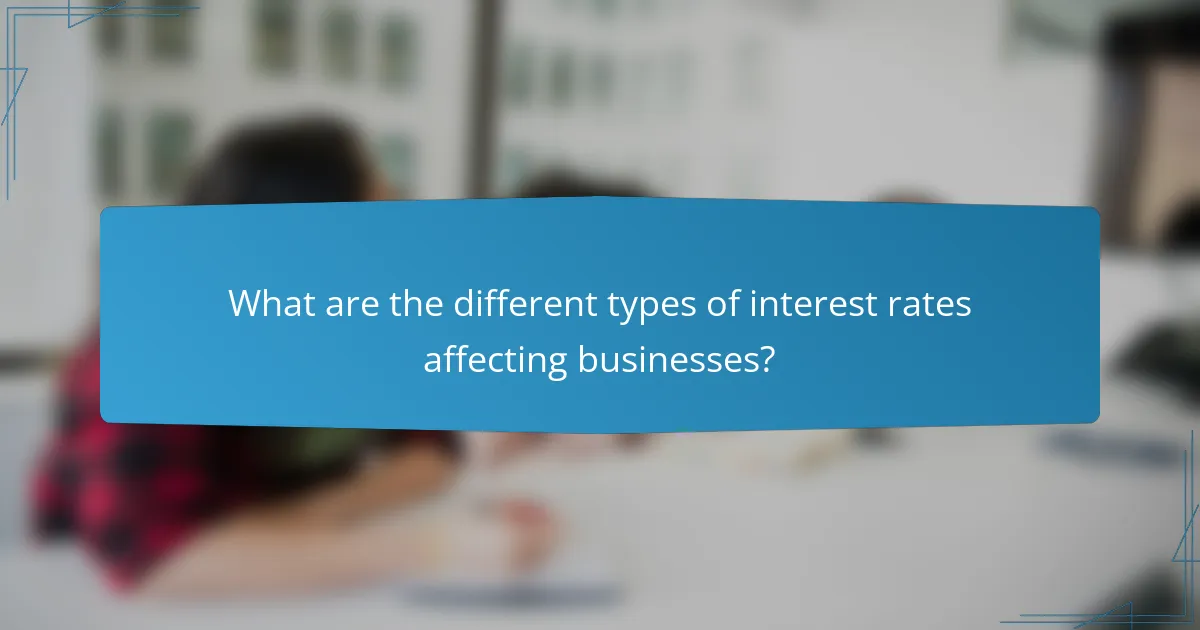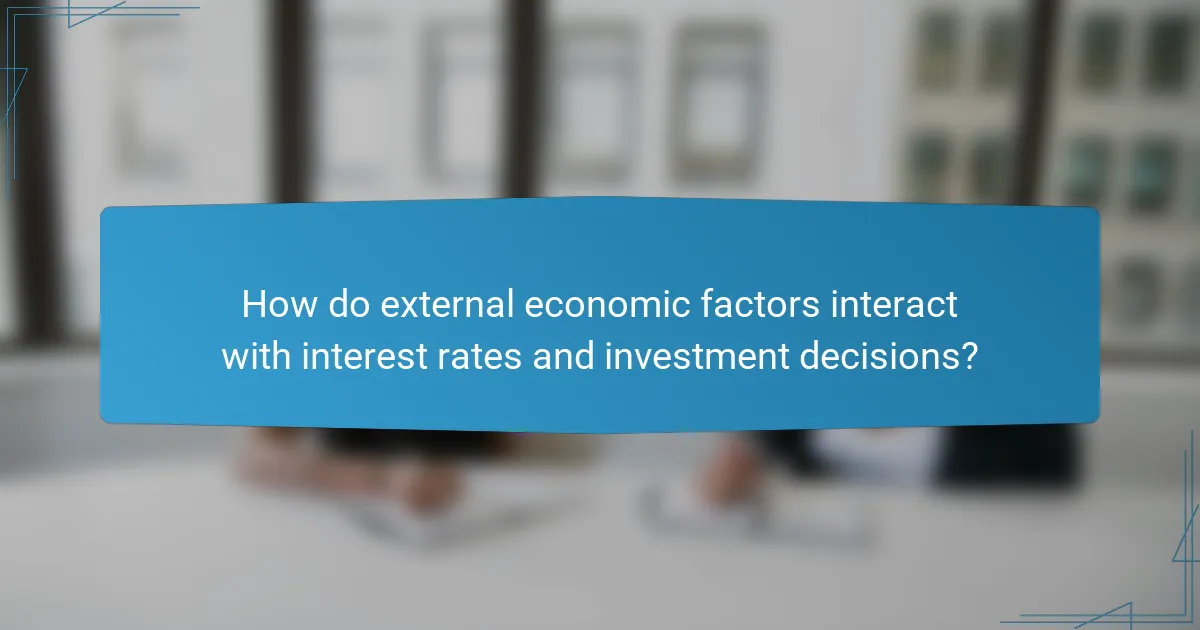Interest rates play a critical role in shaping business investment decisions by influencing borrowing costs. Higher interest rates typically lead to reduced capital expenditure as companies may postpone or limit investments in new projects, while lower rates encourage more investment. Various types of interest rates, including fixed, variable, and prime rates, affect how businesses plan and manage their finances. Additionally, external economic factors such as inflation and economic growth can alter central bank policies, further impacting interest rates and investment behaviors. Historical examples, such as the Federal Reserve’s actions during the COVID-19 pandemic, illustrate the dynamic relationship between interest rates and business investment.

What is the impact of interest rates on business investment decisions?
Interest rates significantly influence business investment decisions. Higher interest rates increase the cost of borrowing. This leads to reduced capital expenditure by businesses. Companies may delay or scale back investments in new projects. Conversely, lower interest rates decrease borrowing costs. This encourages businesses to invest more readily. Historical data shows that a 1% increase in interest rates can reduce investment by 3% to 5%. The Federal Reserve’s decisions on interest rates directly impact business confidence and spending.
How do interest rates influence business borrowing costs?
Interest rates directly influence business borrowing costs by determining the price of loans. When interest rates rise, borrowing costs increase for businesses. Higher costs can deter companies from taking loans for expansion or investment. Conversely, lower interest rates reduce borrowing costs, encouraging businesses to invest. For example, a 1% increase in interest rates can raise loan payments significantly. This can lead to decreased capital investment in the economy. Historical data shows that during periods of low interest rates, business investment tends to rise. This relationship highlights the critical role of interest rates in shaping business financial decisions.
What are the mechanisms through which interest rates affect loan availability?
Interest rates affect loan availability primarily through the cost of borrowing and lender risk assessment. Higher interest rates increase the cost of loans. This discourages borrowers from taking out loans. As borrowing costs rise, demand for loans tends to decrease. Lenders also become more cautious when interest rates are high. They assess the risk of default more stringently. This can lead to stricter lending criteria. Conversely, lower interest rates reduce borrowing costs. This encourages more borrowers to seek loans. Increased loan demand can lead to more favorable lending conditions. Historical data shows that during periods of low interest rates, loan applications typically rise significantly.
How do fluctuations in interest rates alter the cost of capital for businesses?
Fluctuations in interest rates directly impact the cost of capital for businesses. When interest rates rise, borrowing costs increase. This makes loans more expensive for companies. Higher costs can lead to reduced investment in projects. Conversely, when interest rates fall, borrowing becomes cheaper. This encourages businesses to take on more debt. Lower costs can stimulate investment and expansion. Historical data shows that a 1% increase in interest rates can raise corporate borrowing costs by approximately 10%. Thus, businesses must adapt their investment strategies based on interest rate trends.
Why are interest rates a critical factor in investment planning?
Interest rates are a critical factor in investment planning because they directly influence the cost of borrowing. When interest rates are low, borrowing costs decrease. This encourages businesses to take loans for expansion and investment. Conversely, high interest rates increase borrowing costs. This discourages investment and can slow economic growth.
Historical data shows that a 1% increase in interest rates can reduce investment spending by approximately 10%. This illustrates the sensitivity of investment decisions to interest rate changes. Additionally, interest rates affect the returns on savings and investments. Higher rates can lead to increased returns on fixed-income investments, making them more attractive compared to stocks.
Therefore, understanding interest rate trends is essential for effective investment planning. Investors must consider the current interest rate environment when making long-term financial decisions.
What role do interest rates play in determining the timing of investments?
Interest rates significantly influence the timing of investments. When interest rates are low, borrowing costs decrease. This encourages businesses to invest sooner rather than later. Conversely, high interest rates increase borrowing costs. This often leads to delayed investment decisions. Historical data shows that during periods of low interest rates, such as the post-2008 financial crisis, investment levels rose substantially. A study by the Federal Reserve found that a 1% decrease in interest rates can boost business investment by approximately 10%. Thus, interest rates are a critical factor in determining when businesses decide to invest.
How do varying interest rates affect risk assessment in investment decisions?
Varying interest rates significantly impact risk assessment in investment decisions. Higher interest rates generally increase the cost of borrowing. This leads to a higher required return on investment. Investors may perceive projects as riskier due to increased financial obligations. Consequently, they may demand a greater risk premium. On the other hand, lower interest rates reduce borrowing costs. This can make investments more attractive and perceived as less risky. Historical data shows that during periods of low interest rates, investment activity often increases. For instance, the Federal Reserve’s rate cuts in 2008 led to a surge in business investments. Thus, the relationship between interest rates and risk assessment is crucial for informed investment decisions.

What are the different types of interest rates affecting businesses?
There are several types of interest rates affecting businesses. These include fixed interest rates, variable interest rates, and prime rates. Fixed interest rates remain constant throughout the loan term. This stability allows businesses to plan their finances more effectively. Variable interest rates fluctuate based on market conditions. This can lead to lower initial payments, but the risk is that costs may increase over time. Prime rates are the interest rates banks charge their most creditworthy customers. Many loans for businesses are tied to the prime rate, impacting borrowing costs. Additionally, discount rates set by central banks influence overall lending rates. Understanding these rates is crucial for effective business investment decisions.
How do nominal and real interest rates differ in their impact?
Nominal interest rates represent the stated rate without adjusting for inflation. Real interest rates account for inflation, reflecting the true cost of borrowing. The impact of nominal rates is influenced by inflation expectations. Higher nominal rates can discourage borrowing if inflation is also high. Real rates directly affect purchasing power and investment decisions. When real rates are low, borrowing is more attractive. Conversely, high real rates can deter investment due to increased costs. Research shows that real interest rates are more indicative of economic growth than nominal rates. For example, the Federal Reserve’s adjustments often focus on real rates to stimulate investment.
What is the significance of inflation in understanding real interest rates?
Inflation significantly impacts the understanding of real interest rates. Real interest rates are calculated by adjusting nominal interest rates for inflation. This adjustment reflects the true cost of borrowing and the real yield on investments. When inflation rises, the purchasing power of money decreases. Consequently, nominal interest rates may increase to compensate for this loss. Understanding this relationship helps businesses make informed investment decisions. For instance, if inflation is high, a lower real interest rate may encourage borrowing for expansion. Conversely, high real interest rates can deter investment. Therefore, analyzing inflation is crucial for assessing the economic environment and making strategic business choices.
How do central bank rates influence market interest rates?
Central bank rates directly influence market interest rates by setting the benchmark for borrowing costs. When a central bank raises its rates, it becomes more expensive for commercial banks to borrow money. Consequently, banks pass these higher costs onto consumers and businesses through increased loan rates. Conversely, when central banks lower their rates, borrowing becomes cheaper. This reduction encourages spending and investment by businesses and consumers. Historical data shows that a 1% increase in central bank rates typically leads to a 0.5% to 1% rise in market interest rates. Therefore, central bank rates serve as a crucial tool in shaping overall economic activity.
What are the implications of fixed versus variable interest rates for businesses?
Fixed interest rates provide stability for businesses by locking in borrowing costs. This predictability aids in budgeting and financial planning. It protects against market fluctuations. Variable interest rates, however, can lead to lower initial costs. They may benefit businesses if rates decrease over time. Yet, they introduce uncertainty. Increased rates can raise overall expenses significantly. According to a 2020 survey by the National Federation of Independent Business, 60% of firms prefer fixed rates for this reason. Therefore, the choice between fixed and variable rates directly impacts financial strategy and risk management for businesses.
How do fixed interest rates provide stability for investment decisions?
Fixed interest rates provide stability for investment decisions by ensuring predictable repayment amounts. Investors can forecast cash flows with certainty when interest rates remain constant. This predictability reduces the risk associated with fluctuating market rates. Consequently, businesses are more likely to commit to long-term projects. Historical data shows that fixed rates often lead to increased investment during economic uncertainty. For example, during the 2008 financial crisis, many firms opted for fixed-rate loans to mitigate risk. This stability encourages businesses to expand operations and hire more employees. Ultimately, fixed interest rates foster a conducive environment for sustained economic growth.
What risks do variable interest rates pose for long-term investments?
Variable interest rates pose significant risks for long-term investments by introducing uncertainty in future cash flows. Fluctuating rates can lead to higher borrowing costs over time. This unpredictability makes it challenging for investors to forecast returns accurately. For instance, if rates increase, the cost of servicing debt can rise sharply. Historical data shows that a 1% increase in interest rates can reduce investment returns by approximately 10%. Additionally, variable rates can affect market stability, leading to decreased investor confidence. Long-term investments may also become less attractive compared to fixed-rate options during periods of rising rates.

How do external economic factors interact with interest rates and investment decisions?
External economic factors significantly influence interest rates and investment decisions. Factors such as inflation, economic growth, and unemployment rates can affect central bank policies. When inflation rises, central banks often increase interest rates to control price levels. Higher interest rates can discourage borrowing and reduce investment by businesses. Conversely, during periods of economic growth, lower interest rates can stimulate investment by making borrowing cheaper. Historical data shows that in 2020, the Federal Reserve lowered rates to near-zero to encourage investment during the COVID-19 pandemic. This action led to increased capital expenditures in various sectors. Thus, external economic factors create a dynamic interaction with interest rates that ultimately shapes business investment decisions.
What role does economic growth play in shaping interest rates?
Economic growth significantly influences interest rates. When an economy grows, demand for credit typically increases. Higher demand for borrowing can lead to increased interest rates. Central banks often adjust rates to manage inflation during periods of growth. For example, the Federal Reserve may raise rates to prevent overheating in the economy. Historical data shows that in times of robust growth, like the late 1990s, interest rates rose as borrowing surged. Conversely, during economic slowdowns, interest rates tend to decrease to stimulate growth. This relationship highlights the dynamic interplay between economic growth and interest rates in financial markets.
How do interest rates respond to changes in economic indicators such as GDP?
Interest rates typically rise when GDP growth is strong and fall during economic downturns. This relationship occurs because central banks adjust rates to influence economic activity. When GDP increases, it signals higher demand and inflation risks. To combat inflation, central banks may increase interest rates. Conversely, if GDP contracts, central banks lower rates to stimulate borrowing and investment. Historical data shows that during the 2008 financial crisis, the U.S. Federal Reserve reduced rates to near zero in response to declining GDP. This adjustment aimed to encourage economic recovery by making loans cheaper. Thus, interest rates are a tool for managing economic fluctuations linked to GDP changes.
What impact do geopolitical events have on interest rates and investment behavior?
Geopolitical events significantly influence interest rates and investment behavior. These events can create uncertainty in financial markets. As a result, central banks may adjust interest rates to stabilize the economy. For instance, during geopolitical tensions, investors often seek safer assets. This behavior can lead to lower yields on government bonds. Consequently, lower yields can drive interest rates down. Historical examples include the 2008 financial crisis and its impact on rates. Similarly, the COVID-19 pandemic prompted rate cuts worldwide. Overall, geopolitical events shape economic conditions that directly affect interest rates and investment strategies.
How can businesses strategically respond to changing interest rates?
Businesses can strategically respond to changing interest rates by adjusting their financing strategies. They can lock in lower rates through fixed-rate loans when interest rates are low. This reduces future interest expenses and stabilizes cash flow. Conversely, when rates rise, businesses might prioritize paying off variable-rate debt to minimize exposure to higher costs.
Additionally, companies can reassess investment projects based on the cost of capital. Higher interest rates typically increase the cost of borrowing, leading to more cautious investment decisions. For instance, a study by the National Bureau of Economic Research found that a 1% increase in interest rates can reduce business investment by approximately 10%.
Moreover, businesses may consider refinancing existing debt to take advantage of favorable conditions. They can also explore alternative financing options, such as equity financing, to reduce reliance on debt. Keeping a close watch on economic indicators will help businesses anticipate rate changes and adapt their strategies accordingly.
What best practices can businesses adopt to mitigate interest rate risks?
Businesses can mitigate interest rate risks by employing several best practices. First, they can use interest rate hedging strategies, such as interest rate swaps or options. These financial instruments allow businesses to lock in rates and protect against fluctuations. Second, maintaining a diverse debt portfolio can reduce exposure to interest rate changes. This involves using fixed-rate and variable-rate loans strategically.
Third, businesses can conduct regular interest rate risk assessments. These assessments help identify vulnerabilities in their financial structure. Fourth, increasing cash reserves provides a buffer against rising interest costs. This enables businesses to manage payments effectively during periods of high rates.
Fifth, engaging in scenario planning allows businesses to prepare for various interest rate environments. This proactive approach helps in making informed investment decisions. According to a report by the Financial Stability Board, effective risk management practices can significantly reduce the impact of interest rate volatility on business operations.
How can firms leverage interest rate forecasts in their investment planning?
Firms can leverage interest rate forecasts to optimize their investment planning. By analyzing projected interest rates, firms can make informed decisions about financing options. Lower interest rates typically reduce borrowing costs, making investments more attractive. Conversely, higher rates may prompt firms to delay or scale back investments.
Forecasts provide insights into the timing of investments, allowing firms to capitalize on favorable conditions. For example, if rates are expected to rise, firms may accelerate capital expenditures to lock in lower rates. Additionally, understanding interest rate trends can help firms manage cash flow and liquidity effectively.
Data from the Federal Reserve shows that an increase in rates can lead to a significant decline in business investment. Historical trends indicate that firms that align their investment strategies with interest rate forecasts tend to achieve better financial outcomes.
The main entity of the article is interest rates and their impact on business investment decisions. The article analyzes how fluctuations in interest rates influence borrowing costs, capital expenditure, and investment timing for businesses. It discusses the mechanisms through which interest rates affect loan availability and risk assessment, as well as the significance of fixed versus variable rates. Additionally, the article explores external economic factors, including inflation and geopolitical events, that interact with interest rates, ultimately shaping business investment strategies.